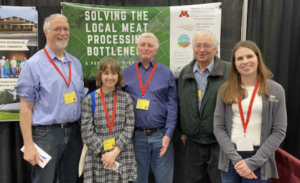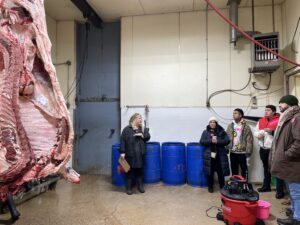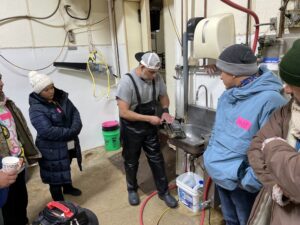Final report for ONC22-113
Project Information
Minnesota Farmers Union and the Latino Economic Development Center worked together to expand opportunities for sustainable livestock farmers to serve the growing demand for locally-raised sustainable meat. The constraint in the farmer-to-consumer system is local slaughter and processing capacity. For instance, one farmer participant emphasized that during the COVID-19 pandemic, they had a very difficult time getting and keeping access to their processor to slaughter/process their animals.
Existing lockers designed to serve individual farmers and their customers are booked out more than a year with the overflow of animals from the industrial meat production system. Most report a shortage of workers to expand or even sustain their operations. Many local lockers have closed in recent years due to a shortage of people willing and able to buy and run them.
The Assuring Meat Processing Availability for Sustainable Livestock Farmers project is designed to directly address the shortage of workers, managers and owners of local meat processors. The focus will be on recruitment of Latino and other BIPOC communities to these positions.
This project will:
* Propose a ready-to-implement apprenticeship training program for workers including recruitment, training structure, funding and placement.
* Design a post-apprenticeship placement and support system including plant acquisition and management, business plan development, access to capital, and immigration status support.
* Create sustainable livestock farmer-to-consumer marketing training and support.
Ready to implement meat cutting/plant ownership Apprenticeship Program
Arrangements for pre-apprenticeship training.
List of plants willing to host/train apprentices.
Apprentice Recruitment plan in place.
Plan to financially support apprenticeships and reward host plants.
Post apprenticeship job placement system in place.
Post apprenticeship BIPOC meat processing plant acquisition and ownership support system.
Meat processing plant model business plan for BIPOC and socially disadvantaged potential owners.
Business plan for a sustainably raised meat processing plant with farmer/employee/customer ownership including significant BIPOC representation.
Farmer to consumer Marketing Program developed for socially disadvantaged farmers to sell their sustainably raised meat.
Immigration status support system.
Cooperators
- - Technical Advisor (Educator)
- - Technical Advisor (Educator)
- - Technical Advisor (Educator)
- - Technical Advisor (Educator)
Research
Thirteen people gathered for a focus group in Rochester, Minnesota, on March 29, 2023 to discuss their small scale livestock production, marketing, and purchasing experiences. Nine participants raised and marketed livestock using various approaches. Two participants owned or managed meat processing facilities. One person was a livestock buyer for the Afghan community. Two participants were from this project and guided the discussions; one of those was a Market Connector.
Participants were drawn from the Latino, Afghan and majority communities of Minnesota, western Wisconsin, and northern Iowa. Marketing approaches discussed included CSAs, farmers markets, on-line marketing, and use of market connectors or aggregators. Pros and cons of each approach were examined, including direct costs, time intensity, travel, specialized knowledge, ability to set prices and market all available products profitably. The special opportunity presented by demand for fresh halal meat was discussed extensively.
Community Supported Agriculture (CSA) shares involve a fixed up front investment in the farm operation, in return for a specific number of deliveries/pick-ups of shares of the farm products over time.
Advantages identified include:
- Funds provided to the farmer up front;
- Weather and production risks shared with farmer and consumer;
- Farmers control prices – within limits of “what the market will bear;”
- Opportunity for on-going engagement with customers
Disadvantages discussed include:
- Time intensive preparing shares/delivering, communicating with customers;
- Meat shares require strict temperature control and delivery timing;
- Dividing products evenly among shares is difficult;
- Lots of time on spreadsheets
Farmers Markets – discussion included farmers with experience in smaller, local farmers markets, and bigger markets further away in big cities.
Advantages discussed include:
- Direct contact with customers – ability to sell what’s available;
- Customers care about story of the farm more than price;
- Big City markets offer premium pricing;
- Visibility complements other forms of marketing;
- Good way to get volume accounts;
- Farmers control the pricing;
- Good place to sell hamburger!
Disadvantages discussed include:
- Fees and licensing costs;
- Travel time and expense;
- Giving up every Saturday (or other day) away from family and farm;
- Need to educate consumers with recipes for unusual meat cuts;
- Small town markets are more price sensitive;
- Lots of work prepping, hauling products to and from the market.
Online marketing – is often used in conjunction with another marketing method, to raise profile, tell stories and take orders, which may be picked up (e.g. at a farmers market) or delivered (e.g. at a CSA distribution site.) Participants in the focus group used online marketing in these manners. Some operations are 100% virtual, with direct shipping to a customer’s address.
Advantages of online marketing include:
- Efficient way to seek and engage especially younger customers;
- Facebook Marketplace is a good way to attract Latino customers;
- Low cost marketing;
- “The store is always open”;
- Expands marketing to wider audiences beyond local contacts;
- Flat rate pricing vs. per pound – easier to sell products available;
- Online customers seem less price sensitive than in-person;
- Can aggregate products from multiple farms to provide “one stop shopping.”
Disadvantages of online marketing include:
- Specialized knowledge/expense to create and maintain web presence;
- Constant need to create and update information, respond to customers;
- 24/7/365 nature has customers expecting immediate responses;
- Shipping of product is expensive and time consuming;
- Hard to maintain consistency of products through seasons, across multiple farms;
- Lack of engagement at an in-person level – field days for customers a solution.
Market Connectors/Aggregators and Food Hubs – these are used by and/or were several of the participants in the focus group. Businesses which run the online marketing and delivery, such as Market Wagon in Minneapolis, mark up the represented products 25%, while the non-profit Iowa Food Hub doing similar work is supported by grants, as well as a more modest 10% mark up on the products.
Advantages of using Market Connectors and Food Hubs include:
- Allows the farmer to focus their time on crop and livestock production;
- Farmers set their own prices;
- No specialized marketing expertise by the farmer required;
- Exposes the farm products to a large customer base;
- Complimentary to other marketing methods.
Disadvantages of using Market Connectors and Food Hubs include:
- No direct contact with customers, unable to develop a relationship;
- Need for a consistent product – to match the marketing;
- Sales may not match production in type or volume.
The unmet demand for fresh halal meats was discussed. Halal products serve a specialized market serving devout Muslims looking for fresh meat products raised and slaughtered in conformance with specific Muslim standards. There are third party halal certifications akin to organic certification to reassure customers that standards are met.
Minnesota has a large and growing Muslim population that seeks halal meat, preferably fresh. Less than 10% of the demand for lamb and goat is supplied from within Minnesota. At this writing, no slaughter facilities are dedicated halal plants. (Two small processors are actively working to become dedicated halal goat and sheep processors.) Demand and prices for goats and sheep are strong, particularly around the Muslim holidays of Ramadan and Eid.
Findings: There is a role for each of the marketing methods discussed in supporting and expanding the growing local foods market. The best method of marketing for an individual farm operation depends upon many factors, including:
- Time available for direct marketing vs. production.
- Location of farm – near or far from large, profitable markets
- Expertise available among the farm family/workers; websites take attention!
- Availability of Food Hubs or Connectors, or local farmers markets.
- Personal preference – some like customer interactions, some do not.
While the approach used to direct market to retail and business consumers varies based on specific factors unique to each farm operation, all participants were supporters of direct marketing, primarily because the farmer gets to set their own prices. While the general market must be considered, it does not dictate final compensation.
Direct marketing puts the farmer back in charge of their own economic future. An additional benefit of direct marketing is the ability with most approaches to develop a deep and ongoing relationship with customers. Such a relationship allows communication of the values embedded in the product (GMO, hormone, and antibiotic free; organic; free-range, etc.) as well as telling the compelling story of the farm and farm family involved. The story and values in turn, justify “a living wage” for the product, a rarity for farmers dependent upon commercial commodity markets.
Direct relationships allow the farmer to shape their marketing to available or surplus products: “These certified organic onions were too small for my contract with a wholesaler, you can have them for a good price.” Or, “This pig weighs 320 pounds, I’d receive half price at the auction because the pork chops are too big. Thank you for buying it for a fair price.” Direct marketing to consumers who learn about the challenges of commercial marketing turns unsaleable surplus or out of spec products into cash.
Finally, production of livestock produced and slaughtered for fresh meat in conformance with halal standards represents a huge opportunity for farmers in Minnesota and the surrounding area. Livestock in demand by area Muslim communities include goats, sheep, cattle and chickens. Goats are in particularly short local supply, with hundreds of thousands of animals imported mostly as frozen halal meat from Australia and New Zealand. Fresh meat is preferred over frozen meat by many customers, despite the higher price. The bottleneck in local halal fresh meat production is the present lack of full time, certified halal slaughter facilities.
Educational & Outreach Activities
Participation Summary:
Consultations: We consulted with 10 owners of local lockers who wish to sell their businesses.
We also consulted with about 15 prospective apprentice-to-owners, evaluating them for readiness to succeed in ownership.
Fact sheets: We published a first-year project report, a business training manual for immigrant owners, a structured apprenticeship program manual/workbook for participants, and a structured apprenticeship framework.
Online training: We planned and facilitated one online training with immigration attorneys that answered employer questions about employing immigrant workers, and the basics of immigration regulations and paperwork as it relates to employing immigrant workers in the agricultural sector. 10 pre-submitted questions from processors were answered in the presentation, and additional questions from attending processors were discussed live during the online training. There were 8 processor attendees, including MAMP board members. The online training was recorded and is now available as an online resource for all trade association members.
Webinars, talks, and presentations: We gave presentations on the structured apprenticeship model at the annual meeting and two board meetings of the Minnesota Association of Meat Processors (MAMP); to the Minnesota Farmers Union Board; to the University of Minnesota Regional Sustainable Development Partnerships; to the Minnesota Department of Agriculture Ag Development and Marketing Team; to the Agricultural Utilization and Research Institute; the Minnesota Farmers Union Meat Processing Working Group; Senator Tina Smith's office; the National Association of State Food and Meat Inspection Departments (NASFMID) annual conference; the Missouri Rural Crisis Center and Iowa CCI;
and participated in the Midwest Association of State Departments of Agriculture (MASDA) Meat Processing panel at their 2023 annual conference;

Learning Outcomes
Direct marketing, transition resources, difficulty in hiring practices when it comes to immigration, awareness of halal demand and market opportunities, need for succession resources for small processors, workforce development resources and apprentice-to-own opportunities, awareness of difficulties in direct sales.
Project Outcomes
We developed a structured apprenticeship model, business manual, and accompanying workbooks for transitioning owners and apprenticeship to use in a meat processing setting, which will be useful templates for future processors looking to sell their business in a sustainable, community-minded way. These materials are adaptable and flexible to meet individual and business needs and circumstances. Three apprentices were paired with processing business owners for piloting the structured apprenticeship model – two intended to own the processing businesses at which they are training after the apprenticeship, while the third intends to purchase her own plant upon completion of the apprenticeship. One apprentice ended up dropping out of the apprenticeship due to family commitments unrelated to processing. Two more BIPOC apprentice-to-own candidates were matched and supported in the transition process with small meat processing business owners looking to sell, with the sale agreement preceding the apprenticeship. In that process, we identified a few specific barriers to pairing owners and apprentice-to-own candidates: immigration barriers such as visa type, financial background of the apprentice, owner having the right timeline to work with the apprentice's needs, the need for assurances on both sides (that the apprentice party would be chosen as buyers, the business is lucrative, that the apprentice can get capital etc.) Financial backing, interest in long term processing work, and necessary skills to start were also identified as important by our community partners, and that this process is understandably complicated and dependent on individual circumstances. We were also informed of an additional plant for sale, and our partners at LEDC are in the process of identifying a suitable apprentice-to-own candidate for the plant. As a result of our work, we are now developing relationships with other cultural development organizations to expand BIPOC apprenticeship identification and participation. Our language supporting apprenticeships in meat processing is in the process of being added to federal marker bill language.
Information Products
- Meat Processing Apprenticeship: Learner Competency Workbook
- Meat Processing Apprenticeship: Structured Apprenticeship Framework
- Meat Processing Apprenticeship: Meat Processing Leadership and Business Management Manual
- MFU Bottleneck Project Website
- Meat Processing Apprenticeship Pamphlet
- Immigration and Hiring Webinar for Meat Processors
- Meat Processing Apprenticeship Presentation

